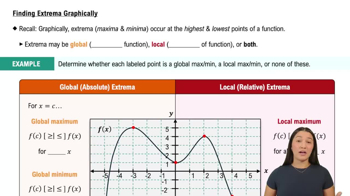Table of contents
- 0. Functions7h 52m
- Introduction to Functions16m
- Piecewise Functions10m
- Properties of Functions9m
- Common Functions1h 8m
- Transformations5m
- Combining Functions27m
- Exponent rules32m
- Exponential Functions28m
- Logarithmic Functions24m
- Properties of Logarithms34m
- Exponential & Logarithmic Equations35m
- Introduction to Trigonometric Functions38m
- Graphs of Trigonometric Functions44m
- Trigonometric Identities47m
- Inverse Trigonometric Functions48m
- 1. Limits and Continuity2h 2m
- 2. Intro to Derivatives1h 33m
- 3. Techniques of Differentiation3h 18m
- 4. Applications of Derivatives2h 38m
- 5. Graphical Applications of Derivatives6h 2m
- 6. Derivatives of Inverse, Exponential, & Logarithmic Functions2h 37m
- 7. Antiderivatives & Indefinite Integrals1h 26m
- 8. Definite Integrals3h 25m
5. Graphical Applications of Derivatives
Intro to Extrema
Problem 4.1.19
Textbook Question
Sketch the graph of a continuous function ƒ on [0, 4] satisfying the given properties.
ƒ' (x) = 0 for x = 1 and 2; ƒ has an absolute maximum at x = 4; ƒ has an absolute minimum at x= 0; and ƒ has a local minimum at x = 2.
 Verified step by step guidance
Verified step by step guidance1
Identify the critical points of the function ƒ by analyzing the derivative ƒ' (x) = 0 at x = 1 and x = 2, which indicates potential local extrema.
Determine the behavior of the function at the endpoints of the interval [0, 4]. Since ƒ has an absolute minimum at x = 0, evaluate ƒ(0) to establish the minimum value.
Since ƒ has an absolute maximum at x = 4, evaluate ƒ(4) to establish the maximum value, ensuring that this point is higher than the values at the critical points.
Analyze the local minimum at x = 2. Since ƒ' (x) changes from negative to positive at this point, the function should decrease to x = 2 and then increase afterward.
Sketch the graph by plotting the points and ensuring the function is continuous, connecting the points smoothly while respecting the identified extrema and the overall behavior of the function.
Recommended similar problem, with video answer:
 Verified Solution
Verified SolutionThis video solution was recommended by our tutors as helpful for the problem above
Video duration:
3mPlay a video:
Was this helpful?

 5:58m
5:58mWatch next
Master Finding Extrema Graphically with a bite sized video explanation from Callie
Start learning





